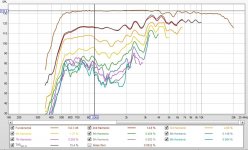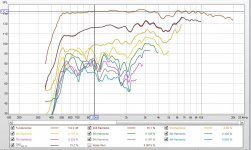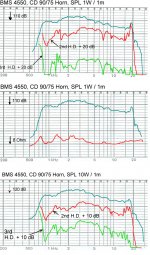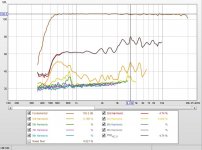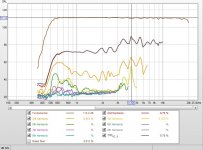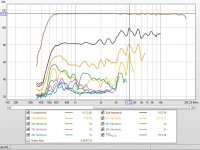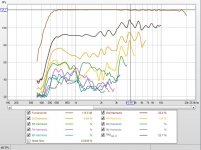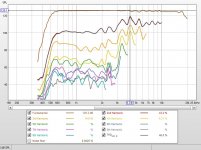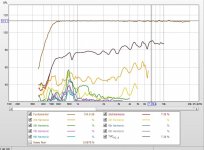Hi Mark, I would be particularly interested to see the distortion results at realistic levels for live sound use, ie at 28.3V @ 10M if your able to if you can.
THD plots, dcx464 and bms4594he, taken at same time on xti1464.
In a clothes closet, mic 6" from mouth.
SPL is accurate.
Freq response is accurate, not normalized.
1/48th smoothing, no windows or gating. (Obviously EQ'ed very flat, was trying out a new FIR technique.)
THD % are at 1kHz (996Hz)
I'll need to get outside and run tests at much higher levels to really know anything...but maybe these help anybody thinking about using either of these drivers for home-fi...
DCX464 first ....this is it's thread, huh? 🙂
The most important / noticable measurement is 3rd harmonic distortion - 0.0077% Vs 0.0068%.
At the level you tested them I don’t think you can tell much. As you said you need to test them at a higher SPL … where the distortion level has increased quit a bit.
When pushed, I thought the 464 seemed to have a slight advantage over the 4594, it sounded clearer and less stressed … but that’s just an early first impression.
My gut feeling (at the moment and subject to change) is the 4594HE for HiFi & home theartre where the SPLs are comparitivly low and the 464 for high SPL PA use.
Looking forward to some more results 🙂
BTW what crossover did you use on these drivers for the test?
Last edited:
Hi guys,
@ pelanj....no, i wouldn't say the BMS has considerably lower distortion at the same level..
because imo distortion is so very low for both...that was what i hoped folks saw...that either are super for in-home levels
@SubSoniks .... I hope to make some high level sweeps very soon. But they won't be at 10m, it will be at about 2-3m. And then pulled back to 1m.
I like the 'Danley' 28.3v/10m measurement method, but i think even they only use it for subs. But dunno about that..
I do think 10m would make for a tough THD test though, keeping the noise floor low enough..
@ Peter...thanks for adding your comments 🙂
I used 575Hz and 3200Hz xovers on the dcx464,
and 500Hz and 6300Hz xovers on the bms. LR 96db/oct all.
Meant to use 500Hz on both...just screwed up really.
I was trying a neat way of building FIR files where all you do is invert the measurement impulse, and convolve that with xovers. It's crazy easy.
THD was an afterthought, just looking at results...
Mapping out setting up for higher level sweeps, it just hit me...
All my THD test to date have been post-processing where I've looked at 'equal SPL' distortion results. Which i like and make sense to me.
In wanting to give SubSonics some reference voltages, I realized i'll need to ditch processing, other than crossovers.
So now I'm wondering if equal voltage THD measurements make as much sense as equal SPL measurements.
All that said, i guess the industry has always used equal voltage and normalized THD to response. Maybe i need to rethink my equal SPL method..??
@ pelanj....no, i wouldn't say the BMS has considerably lower distortion at the same level..
because imo distortion is so very low for both...that was what i hoped folks saw...that either are super for in-home levels
@SubSoniks .... I hope to make some high level sweeps very soon. But they won't be at 10m, it will be at about 2-3m. And then pulled back to 1m.
I like the 'Danley' 28.3v/10m measurement method, but i think even they only use it for subs. But dunno about that..
I do think 10m would make for a tough THD test though, keeping the noise floor low enough..
@ Peter...thanks for adding your comments 🙂
I used 575Hz and 3200Hz xovers on the dcx464,
and 500Hz and 6300Hz xovers on the bms. LR 96db/oct all.
Meant to use 500Hz on both...just screwed up really.
I was trying a neat way of building FIR files where all you do is invert the measurement impulse, and convolve that with xovers. It's crazy easy.
THD was an afterthought, just looking at results...
Mapping out setting up for higher level sweeps, it just hit me...
All my THD test to date have been post-processing where I've looked at 'equal SPL' distortion results. Which i like and make sense to me.
In wanting to give SubSonics some reference voltages, I realized i'll need to ditch processing, other than crossovers.
So now I'm wondering if equal voltage THD measurements make as much sense as equal SPL measurements.
All that said, i guess the industry has always used equal voltage and normalized THD to response. Maybe i need to rethink my equal SPL method..??
Mark, thank you and apologies as I should have been clearer in my previous post, 28.3V @10M was really only intended to be a high but safe level, making the test at 10M was to ensure the test mic wouldn't get overloaded and add to the distortion as I was unsure of the mic your using, the better ones can handle the levels that those drivers are capable of at the higher levels they can produce, at smaller distances not all can.
Setting reference levels could be usefull though but not something I'm bothered about, I would be very interested in what happens at realistic 'war volume levels' and would love to know your take on the sound of them at high levels.
Setting reference levels could be usefull though but not something I'm bothered about, I would be very interested in what happens at realistic 'war volume levels' and would love to know your take on the sound of them at high levels.
You bet SubSonicks...i hear where you're coming from...
And yep, re mics getting overloaded. I sprung for a Isemcon 7150 to help avoid that problem.
Hope to post some war volume results real soon...
And yep, re mics getting overloaded. I sprung for a Isemcon 7150 to help avoid that problem.
Hope to post some war volume results real soon...
Re equal SPL, I guess most people would be using eq to get them flattish so I guess that would be most relevant and ideally measured just below the onset of power compression. Do you happen to have access to SMAART?
Re equal SPL, I guess most people would be using eq to get them flattish so I guess that would be most relevant and ideally measured just below the onset of power compression. Do you happen to have access to SMAART?
Yep, i think flat makes more sense too.
I do have Smaart...what do have in mind?
Yep, i think flat makes more sense too.
I do have Smaart...what do have in mind?
It was just a thought about working out the max safe level to test at, using smaart it is possible to check for the level that power compression becomes an issue, Meyer have a good guide on a method to use, for setting limiters they use their 'M Noise', for this purpose pink is what REW needs as far as I'm aware, probs all a little OTT though.
One other measurement that would be good to see the results of is IMD which would just need another sweep in REW to produce.
From a previous exploration of compression driver distortion:
Pano,
As it turns out, the dual sine waves really reveal something I failed to catch in the initial 2012 tests, the upper intermodulation distortion (the addition of two fundamental frequencies, 523 + 932 creating a third frequency of 1455, etc.) had been mistaken for ordinary order upper harmonics, resulting in (consistently) under reporting distortion %.
Recent testing of a 3.5" Tymphony TC9FD-18-08 "full range" driver on the same horn found that it had far less IM distortion than the compression drivers, though is not capable of quite as much high frequency output due to less power handling and lower sensitivity.
The tests below (at two meters, add 6 dB for equivalent one meter SPL) show the TC9 has much lower IM distortion than the best of the compression drivers tested, the DH1A.
On 12/13/15 I did an A/B listening test between the TC9 and the (relatively) new Eminence N314T-8 (3" diaphragm 1.4" exit), both on my Maltese 13 x 13 degree conical horns. Although the N314T-8 had less HF distortion than any of the HF drivers previously tested, the TC9FD was cleaner sounding. The TC9FD has far more clean output capability in the 500 Hz range than any HF driver I've tested, though my listening test was using a steep crossover at around 900 Hz.
The TC9FD required more power than the compression driver, but I was amazed at the clarity at the high SPL levels I worked up to. I'm fairly used to the distortion level in speakers telling when to back off power, but the TC9FD gave almost no indication of distress until the voice coil melted the glue off the former and it "gaacked" out over about a 1 second period.
Prior to the TC9FD letting out the magic smoke, it had survived several songs averaging 120 dBA slow at one meter, with peaks of up to 126 dBA. The driver is only rated for 30 watts (IEC 2685, 6 dB crest factor pink noise) so considering the SPL, amazing that it lasted as long as it did, considering peak levels were well in excess of 200 watts.
On the basis of those tests, used eight Maltese horns to make four dual units that can either be used across the downstage lip as center fill, or in quad arrays left and right.
Although the polar response of a quad array of TC9/Maltese horns is not quite as good as hoped for, they make a fine center fill under the SyntripP cabinets, and have plenty of clean output down to 200 Hz to not require additional woofers for the application.
Art
High Frequency Compression Driver Evaluation
What would you consider makes the 4594HE better for hifi?
It has a more extended top end; it will get to 20KHz and sound quality has a sparkle or air to it.
The DCX464 does not go quit as high or sparkle quit as much but it seems to have more SPL capabilities (??). For large scale PA applications where you are often more than 10m away that sparkle or air does not matter very much.
Last edited:
Thanks for your reply, would you say the dispersion of the the two drivers on the same horn is similar?
Thanks for your reply, would you say the dispersion of the the two drivers on the same horn is similar?
Don't know .... but one of the issues with the 4594 is that the VHF wave front is not very even across the mouth - this could have an impact on dispersion, but the protruding phase plug on the HE version may fix this, but that’s just a guess.
The 464 in this respect does not have an issue
It was just a thought about working out the max safe level to test at, using smaart it is possible to check for the level that power compression becomes an issue, Meyer have a good guide on a method to use, for setting limiters they use their 'M Noise', for this purpose pink is what REW needs as far as I'm aware, probs all a little OTT though.
One other measurement that would be good to see the results of is IMD which would just need another sweep in REW to produce.
I figured that's where you headed. Yeah, I'd like to do the whole compression / M-Noise routine, but i can only get away with so much in the neighborhood...especially given that my testing is off a deck pointed out over a large lake ...and carries forever and then some.
Anyway, I'd did get to make a bunch of sweeps of both drivers just now, tuned for flat SPL.
I stopped at 132dB to give folks a break.
SPL is accurate from 1m. Actual distance was 8ft. Same xti1464 again.
First is the dcx464; second the bms4595he
dcx 500Hz and 3.2kHz xovers; bms 500Hz and 6.3kHz
Attachments
Hi Peter Morris,
Thanks a lot sharing your work on the new coax drivers from BMS and B&C🙂.
I know you have also worked with the Beyma TPL200, and I have very much like to hear how the first rate coax's compare to the Beyma TPL.
If you were to build a no compromise hifi/studio monitor (i.e. home use - not PA), would you then base it on the one of the Coax's or the Beyma?
I understand that a comparison is sort of Apples and Oranges as the coax drivers have much more extended frequency range, but I have to ask. The reason is, that I have already got the Beyma TPL150H (which I like), but I am intrigued by the idea of almost having a 'point source' from 300 cycles and up on a sufficiently large horn I have also lying around (Klipsch K402).
Thanks a lot!
Best regards
Peter
Thanks a lot sharing your work on the new coax drivers from BMS and B&C🙂.
I know you have also worked with the Beyma TPL200, and I have very much like to hear how the first rate coax's compare to the Beyma TPL.
If you were to build a no compromise hifi/studio monitor (i.e. home use - not PA), would you then base it on the one of the Coax's or the Beyma?
I understand that a comparison is sort of Apples and Oranges as the coax drivers have much more extended frequency range, but I have to ask. The reason is, that I have already got the Beyma TPL150H (which I like), but I am intrigued by the idea of almost having a 'point source' from 300 cycles and up on a sufficiently large horn I have also lying around (Klipsch K402).
Thanks a lot!
Best regards
Peter
The most important / noticable measurement is 3rd harmonic distortion - 0.0077% Vs 0.0068%.
At the level you tested them I don’t think you can tell much. As you said you need to test them at a higher SPL … where the distortion level has increased quit a bit.
When pushed, I thought the 464 seemed to have a slight advantage over the 4594, it sounded clearer and less stressed … but that’s just an early first impression.
My gut feeling (at the moment and subject to change) is the 4594HE for HiFi & home theartre where the SPLs are comparitivly low and the 464 for high SPL PA use.
Looking forward to some more results 🙂
BTW what crossover did you use on these drivers for the test?
I figured that's where you headed. Yeah, I'd like to do the whole compression / M-Noise routine, but i can only get away with so much in the neighborhood...especially given that my testing is off a deck pointed out over a large lake ...and carries forever and then some.
Anyway, I'd did get to make a bunch of sweeps of both drivers just now, tuned for flat SPL.
I stopped at 132dB to give folks a break.
SPL is accurate from 1m. Actual distance was 8ft. Same xti1464 again.
First is the dcx464; second the bms4595he
dcx 500Hz and 3.2kHz xovers; bms 500Hz and 6.3kHz
Wow, nice work, do please be careful if testing at higher levels as possibly getting a little warm at those levels with pink noise and not sure they would be safe measured much higher?
Re distortion, seems to confirm the trend as shown in the BMS distortion curves in their 4550 published data (kudos to BMS for being brave enough to publish these curves, i don't know of any others that do), looks like at their peak ratings, there could be more distortion produced than the fundamental.
If you do find time and your neighbours are forgiving enough, REW as you probably are aware is able to measure IMD, I have found very little info anywhere on the web about IMD and compression drivers.
Attachments
Mark,I stopped at 132dB to give folks a break.
SPL is accurate from 1m. Actual distance was 8ft. Same xti1464 again.
First is the dcx464; second the bms4595he
dcx 500Hz and 3.2kHz xovers; bms 500Hz and 6.3kHz
Thanks for the comparisons!
The DCX464 THD hits around 90% just above 4kHz, dropping back to around 30% above 4.5kHz. Does distortion in the 3-4 kHz range (where "normal" hearing is most sensitive..) improve if the crossover is raised above 4kHz?
Could you please post some of the lesser (like 120 and 126 dB SPL) distortion sweeps ?
Art
These results are very interesting the harmonic distortion at 130 dB seems similar to the JBL cone midrange horn loaded drivers in this tech note:
https://adn.harmanpro.com/site_elements/executables/19573_1571427998/CMCD_TechNote_original.pdf
Absolute SPL capability is of course lower, but as your results show the harmonic distortion is getting a bit much at 130 dB anyway.
I would be interesting to see at what SPL each driver can keep below 10% THD as a metric of the usable SPL (or is 10% too generous?).
https://adn.harmanpro.com/site_elements/executables/19573_1571427998/CMCD_TechNote_original.pdf
Absolute SPL capability is of course lower, but as your results show the harmonic distortion is getting a bit much at 130 dB anyway.
I would be interesting to see at what SPL each driver can keep below 10% THD as a metric of the usable SPL (or is 10% too generous?).
Thx guys !
Here's a set for the dcx464....... 106 to 126 dB, in 5 dB increments.
With cursor set close to peak THD.
I think i should play with the crossover to try to optimize.
It might be better to share the load between sections...these were steep LR16 xovers....and maybe move xover freq up a little from 3.2kHz...
Here's a set for the dcx464....... 106 to 126 dB, in 5 dB increments.
With cursor set close to peak THD.
I think i should play with the crossover to try to optimize.
It might be better to share the load between sections...these were steep LR16 xovers....and maybe move xover freq up a little from 3.2kHz...
Attachments
These results are very interesting the harmonic distortion at 130 dB seems similar to the JBL cone midrange horn loaded drivers in this tech note:
https://adn.harmanpro.com/site_elements/executables/19573_1571427998/CMCD_TechNote_original.pdf
Absolute SPL capability is of course lower, but as your results show the harmonic distortion is getting a bit much at 130 dB anyway.
I would be interesting to see at what SPL each driver can keep below 10% THD as a metric of the usable SPL (or is 10% too generous?).
Yeah, 10% is kinda an industry standard huh?....
In the set for the dcx, the 111dB plot is the last one that stays below 10%.
I don't have exact matching SPLs for the bms, but here's one at 113dB.
(118dB goes above 10%, to 12.4%)
You'll notice peak THD occurs higher up in frequency.
Oh, on all these plots I've posted....I've noticed on some of them there is a discrepancy between the SPL per the cursor, and the SPL in the chart below.
The cursor is correct. Evidently, when i added 8dB to each plot to account for mic distance, on some i hit REW's 'Add to Data' and others i didn't.
Attachments
- Home
- Loudspeakers
- Multi-Way
- B&C DCX464
